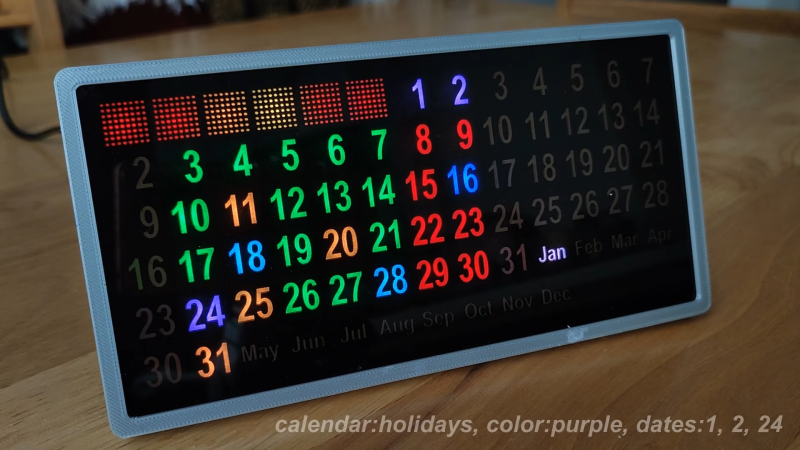Keeping track of your appointments on Google Calendar is easy enough if you’re holding a phone or sitting at a computer, but sometimes you just want to know what’s going on at a glance. This desktop calendar build from [andrei.erdei] does just that with plenty of helpful LEDs.

The design is simple, using WS2812 LEDs to backlight numbers to indicate whether they are weekdays, weekends, anniversaries, holidays, or any other dates of importance. The numerical layout is a nifty perpetual design allowing the display to easily accommodate the structure of any month, even those neat and tidy ones that start on Monday.
The design relies on an ESP-01 to communicate with Google Calendar and display the relevant data. It’s all wrapped up in a 3D printed case, with the printed paper template backlit from behind some smoked acrylic giving a surprisingly professional-looking finish.
If you’re tired of picking up your phone for every last thing, this design could be just what you’re after for keeping track of your appointments. Alternatively, you could always go the hard copy route. Video after the break.
















Meh. Never rely on a google product, even if you pay for it. Google pulls products when they don’t contribute sufficiently to raising funds, so relying on them is a foolhardy move. Cloud “apps” are unreliable and quick to be “upgraded” despite your misgivings and break API compatibility.
That’s a good point. Perhaps it could read data from an excel spreadsheet or xml/json file. The problem is, who keeps their calendar info in an excel doc? Imagine: wait wait wait.. let me put that in my calendar. Let’s see, load up excel, find the file, save, upload to the web, and voila!
Perhaps a custom calender app that can automatically export calendar data to you desk calendar via bluetooth or wifi. That would keep both up to date with no manual steps needed.
Or it could use ical, the standard for calendaring…
You’re not wrong, Walter, you’re just an asshole. This is a neat project.
Lol. Hear hear.
Assuming he’s used the standard iCal feed from Google, it’ll easily switch to read any calendar.
It’s a hobby project, when Google will yank its product, he can readily switch to another solution, assuming his code is properly modular. I like it, I like real-world “passive objects” displaying information instead of having to rely on a smartphone as a single entry point…
The sync is done with some Google specific APIs using Google Apps Script (JavaScript + some standard libraries). https://github.com/SensorsIot/Reminder-with-Google-Calender
I think hosting an iCal feed would get this working in Outlook, Evolution, Kontact, and Mail.App. Probably not a lot of code to write up. I encourage any Real Hackers(tm) to try.
Don’t forget they are also switching off your privacy settings soon with an update. They renamed the option and the default is to allow permission to use your data.